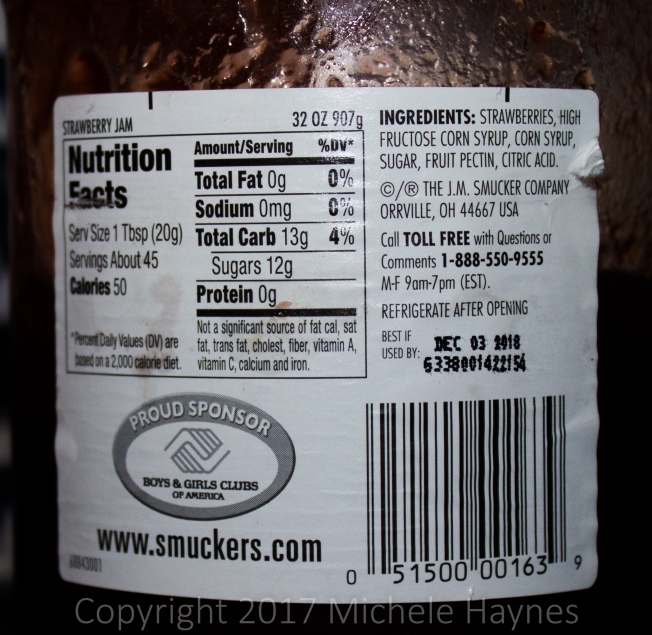I am continuing my discussion of what traditional food products are available for the beloved peanut butter and jelly sandwich or PB&J.
This is one of my comfort foods, and a quick and healthy way to get protein, complex carbs and some calories into me before I engage in active time (versus resting time).
Unfortunately, as I pointed out in my Peanut Butter post in this series, the ingredients available in grocery stores are not so good for us.
Jelly, Jam and Preserves
First of all, let me spend a minute explaining the differences in these three spreads:
- Jelly is made from fruit juice, sugar and pectin.
- Jam is made from crushed fruit, sugar and pectin.
- Preserves are made from fruit and a sugar syrup.

In the Smucker’s Jam photo above, you can see that the first ingredient is strawberries as it should be. Nothing wrong with that. It is the next three ingredients that are concerning:
- High fructose corn syrup (HFCS) – chemically-processed sweetener made from, in over 80% of cases, GMO corn starch. The latest group of genetically-engineered crops are designed to tolerate spraying with a dangerous herbicide plus kill pests in the developing ears and in the ground: SmartStax-RIB Complete.
- Corn syrup – glucose syrup made from, again, GMO corn starch.
- Sugar – unless marked “cane sugar,” when you see sugar in a list of ingredients on a label, it is derived from sugar beets which are mostly GMO in the U.S.
GMO or GE corn is potentially unsafe for humans due to toxic levels of glyphosate and the controversial inclusion of pesticide actions within the fruit itself. Aside from the unsustainable farming practices necessary to grow these crops, HFCS and corn syrup are linked to obesity and are not easily processed by the human body. They should be avoided.
Sugar is necessary for the production of traditional jelly and jams. In studying canning, low-sugar varieties typically are not shelf stable and must be refrigerated. And, honestly, there is nothing wrong with a little sugar in the diet of a healthy person. The amount of jelly or jam that goes on a PB&J sandwich is 1-2 tablespoons at most. When eaten with a protein-rich food such as peanut butter, it is not unhealthy (protein helps the body process sugar).
What is concerning in mainstream jellies and jams is that the sugar comes from GMO sugar beets which are sprayed with ridiculous amounts of glyphosate (the active ingredient in RoundUp) as weeds have become resistant to the herbicide. Glyphosate toxicity is being recorded in Americans. What the FDA considers safe is measured in individual servings, not cumulatively in all the foods that Americans eat in the average diet. Toxicity occurs when too much of something has been consumed. So many food crops are now sprayed with glyphosate that toxicity is being found in more and more people.
- Fruit pectin – usually made from apple pomace or citrus fruit pith.
- Citric acid – fermented from citrus fruit.
The last two ingredients will be found in all jams and jellies, and citric acid is used in preserves as well. Even home canners typically use citric acid crystals to preserve the appearance of fruit (keeps it from browning).
Recommendations
In buying fruit spreads such as jelly, jam and preserves, look for “cane sugar” on the ingredient list. Avoid HFCS and corn syrup.
Buying organic means that you are supporting sustainable agriculture. You consume healthier food and the soil is healed (industrial monoculture results in dead soil) or remains healthy.
Fruit spreads, even expensive organic products, are not an expensive part of food purchases.
Healthy alternative
I prefer to buy organic fruit spreads. These are made from fruit and fruit juice.
If you are adventurous, you can make your own as well. There are simple recipes for refrigerator jam and jelly and freezer alternatives (for larger batches — they must be preserved in some way). Some use fruit, a little sugar and gelatin.
If you are really adventurous, you can delve into the rewarding, albeit exhausting and time-consuming, world of canning. I have made pear butter and pear jam from my own organically-grown pears. After hours (and I mean many hours) of work, my sons ate all of it in 2 days. Sigh.
These days, since I am living in an apartment in Houston, Texas, I buy what I need.
Learning to read labels and understand ingredients is vital to consuming healthy foods that don’t contribute to obesity, diabetes, or heart disease, not to mention diseases caused by toxins (pesticides and herbicides).
Buying organic means fewer toxins and support for sustainable agriculture. It’s up to you.
The next article in this series will address bread. Since I am currently not tolerating wheat, even organic wheat, I am looking for alternatives that don’t make me sick (literally).


















